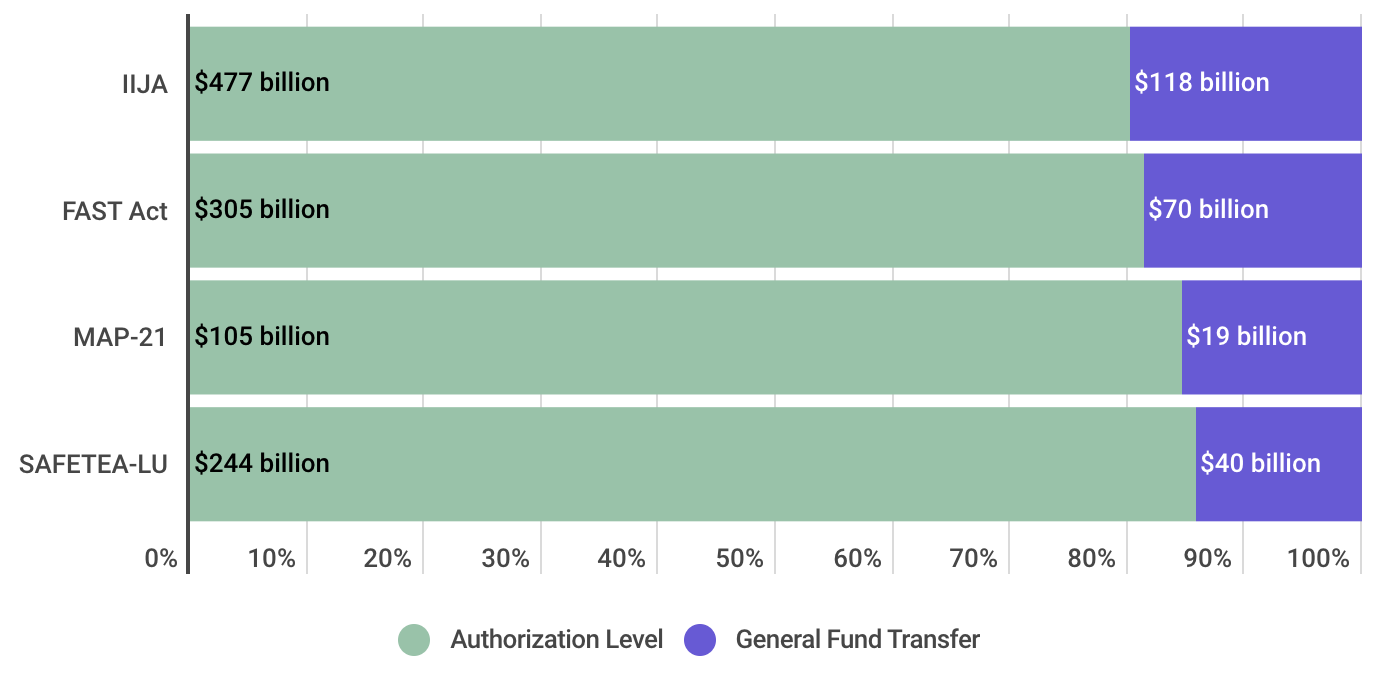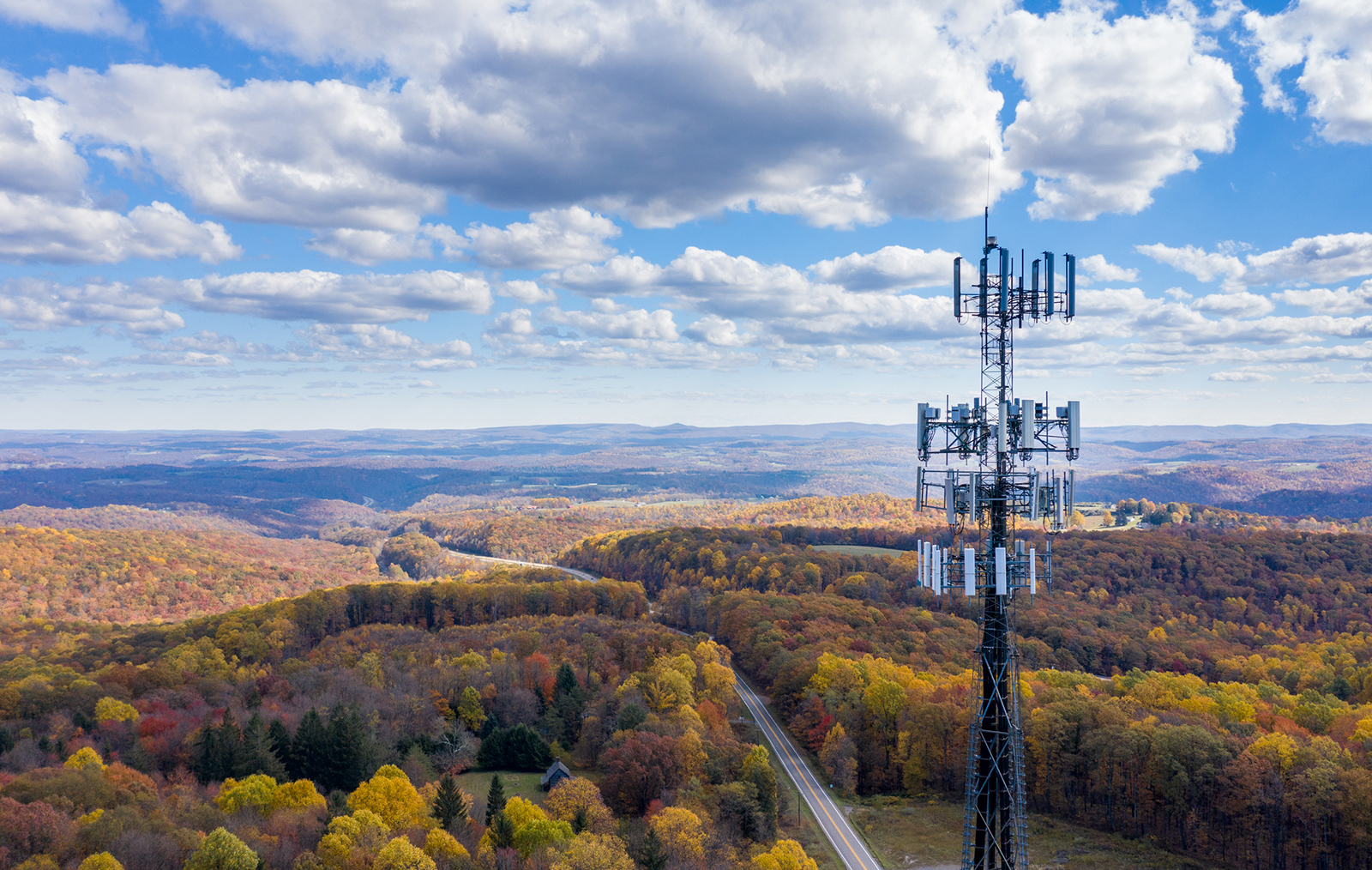Establishes a new competitive grant program for infrastructure "mega projects"
$10 billion over five years
|
Counties can apply directly to USDOT for a new competitive program to provide single or multi-year grants at $2 billion annually over five years to carry out expensive, complex projects, referred to as "mega projects", that have the potential to generate national or regional economic mobility or safety benefits. Other federal assistance could be used to meet local match requirements, not to exceed a maximum of 80 percent federal share. Eligible projects include:
- Highway or bridge projects
- Freight intermodal or freight rail projects with a public benefit, including ports
- Rail-highway grade separation or elimination projects
- Intercity passenger rail projects and public transportation projects
Additionally, to be eligible, project costs must reasonably be projected to either:
- Be equal to or greater than $500 million; or
- Fall between $100 million and $500 million (50 percent of project awards are set-aside to fund these projects)
Certain projects can also be bundled. Eligible project costs include:
- Development phase activities
- Construction, reconstruction and rehabilitation
- Real property procurement
- Environmental mitigation
USDOT is required to ensure geographical diversity and a balance between rural and urban areas in project selections, with 50 percent of the funding reserved for projects between $100 million and $500 million. Should a project not be selected, the applicant can request technical assistance.
TOTAL FUNDING OVER FIVE YEARS
| Authorized from HTF |
Appropriated |
Program Total (subject to appropriations) |
| $10 billion |
$5 billion |
$15 billion |
|
Creates a new competitive grant program to eliminate at-grade rail crossings
$2.5 billion over five years
|
Counties can apply directly to USDOT for these competitive grants, at an 80 percent federal cost share, to meet the following goals of:
- Eliminating frequently blocked at-grade crossings
- Improving the health and safety of communities
- Reducing the impacts of rail operations on underserved communities
- Improving mobility and commerce
$500 million will be provided annually for eligible projects, including:
- Closing or separating at-grade crossings
- Track relocation
- Installing protective devices and other technological solutions that improve safety
- Planning, environmental review and design activities related to an eligible project
At least 25 percent of funds set aside for planning projects in a FY must be awarded to projects in rural areas or on tribal lands. At least five percent of total grant funding is reserved for projects in counties with 20 or fewer residents per square mile.
TOTAL FUNDING OVER FIVE YEARS
| Authorized from GF |
Appropriated |
Program Total (subject to appropriations) |
| $2.5 billion |
$3 billion |
$5.5 billion |
|
Authorizes direct, flexible grant program (formerly BUILD/TIGER) for the first time
$7.5 billion over five years
|
The Rebuilding American Infrastructure with Sustainability and Equity (RAISE) grant program is now an authorized program for the first time. This flexible, competitive grant program – formerly named both BUILD and TIGER by previous administrations – is widely utilized by counties to carry out a variety of eligible infrastructure projects at an 80 percent federal share. The share may be increased at the discretion of USDOT for projects in rural, historically disadvantaged or persistent poverty areas.
Similar to current law, surface transportation projects with significant local or regional impacts are eligible, now including projects to replace and rehabilitate culverts or prevent stormwater runoff. Grant award amounts are limited to $25 million and can be no less than $5 million for urbanized areas and no less than $1 million for rural areas. The 50/50 geographical split for urban-rural project selections remain.
USDOT must publish a Notice of Funding Opportunity (NOFO) for the next round of RAISE awards no later than 270 days following the date that FY 2022 appropriations are made available, the timing of which is currently unclear. USDOT has jurisdiction over the NOFO's award criteria.
TOTAL FUNDING OVER FIVE YEARS
| Authorized from GF |
Appropriated |
Program Total (subject to appropriations) |
| $7.5 billion |
$7.5 billion |
$15 billion |
|
Establishes a new culvert removal, replacement and restoration grant program
$4 billion over five years
|
Counties can apply directly to USDOT for a new competitive grant program to carry out eligible projects that replace, remove or repair culverts that would improve or restore fish passage for certain fish, with a priority given those species who are endangered or at risk of becoming endangered, or projects that address fresh-water runoff that impact certain marine life.
USDOT is required to provide technical assistance to underserved communities. The section authorizes $800 million annually, with a federal share of no more than 80 percent.
TOTAL FUNDING OVER FIVE YEARS
| Authorized from GF |
Appropriated |
Program Total (subject to appropriations) |
| $4 billion |
$1 billion |
$5 billion |
|
Allows local public authorities to enter into multi-state freight compacts
$25 million over five years
|
Counties and other local public authorities, including ports, can enter into multi-state compacts to improve the movement of goods, including assembling rights-of-way and performing capital improvements. A compact could subsequently establish a multi-state advisory freight corridor advisory committee with state departments of transportation and other entities, including local governments.
USDOT is required to establish a grant program to facilitate the efforts of these compacts within the first three years of their inception, authorized at $5 million annually over the life of the bill with a 50 percent non-federal match requirement.
|
Requires USDOT to establish an intergovernmental research group for freight
|
USDOT is required to create a National Cooperative Freight Transportation Research Program to be administered in conjunction with the National Academy of Sciences (NAS). NAS will be required to establish an advisory committee with public and private stakeholders, including local governments and local public authorities, which will be tasked with recommending national research agenda for the program and developing a multi-year strategic plan. NACo will track the creation of this group and push for county inclusion.
|
Establishes a new rural assistance program through the Build America Bureau
|
Counties located outside of an urbanized area with a population of more than 150,000 are eligible to apply directly to USDOT for a new Rural and Tribal Assistance Pilot Program. The program will provide financial, technical and legal assistance; assistance with development-phase activities; and information on innovative financing practices to rural and Tribal communities. It will sunset after five years.
Funding, which will come from "any amount made available to the Secretary to provide credit assistance under an eligible program that is not otherwise obligated," will be authorized at no more than the following levels each year:
- FY 2022: $1.6 million
- FY 2023: $1.8 million
- FY 2024: $2.0 million
- FY 2025: $2.2 million
- FY 2026: $2.4 million
|
Requires consultation with local governments to develop new routes
|
Amtrak is required to consult with states, local governments including counties, relevant commuter and regional transportation authorities, host railroads, the FRA and other stakeholders on the development of new state-supported routes.
|
Creates new reporting requirements for some public transit agencies
|
A public transit entity that owns infrastructure used for intercity rail passengers in the Northeast Corridor (NEC) is required to develop an asset management system to inform Amtrak's NEC capital investment program.
|
Expands eligibilities under the Consolidated Rail Infrastructure and Safety Improvements (CRISI) grant program
$5 billion over five years
354.5% increase from FAST Act
|
CRISI program eligibilities are expanded to include eligibilities for the following:
- Development and implementation of measures to prevent trespassing
- Research and development to advance innovative rail projects
- Preparation of emergency plans for communities through which hazardous materials are transported by rail
TOTAL FUNDING OVER FIVE YEARS
| Authorized from GF |
Appropriated |
Program Total (subject to appropriations) |
| $5 billion |
$5 billion |
$10 billion |
|
Extends Restoration and Enhancement grant program project timelines
$250 million over five years
|
The amount of time the FRA Restoration and Enhancement grant program can provide funds to support a route is extended from three to six years.
Counties can utilize Restoration and Enhancement funds to expand or enhance intercity passenger rail. Counties directly support 78 percent of the nation’s public transit systems, including intercity passenger rail.
|
Reforms and renames the Federal-State Partnership for State of Good Repair grant program
$7.5 billion over five years
150% increase over FAST Act
|
The FRA Federal-State Partnership for State of Good Repair is renamed as the Federal-State Partnership for Intercity Passenger Rail grant program and project eligibilities are expanded to allow for new capacity, including by:
- Expanding or establishing new intercity passenger rail service
- Improving intercity rail service performance and efficiency
- Designating NEPA-related activities an eligible use of funds
TOTAL FUNDING OVER FIVE YEARS
| Authorized from GF |
Appropriated |
Program Total (subject to appropriations) |
| $7.5 billion |
$36 billion |
$42.5 billion |
|
Establishes a new Corridor Identification and Implementation program
|
A new Corridor Identification and Development Program will be established to facilitate the development of intercity passenger rail corridors. Counties are eligible to submit corridor proposals.
|
Requires an evaluation of the Railway-Highway Crossings program
|
USDOT is required to evaluate the requirements of the railway-highway crossings program and whether the structure of the program provides sufficient incentives and resources to states and local agencies to make changes at highway-rail grade crossings that are most effective at reducing deaths, among other goals.
|
Establishes a blocked crossing portal pilot program
|
The FRA is required to establish a blocked crossing portal to collect information about blocked highway-rail grade crossings from the public in order to identify frequent and long-duration blocked highway-rail grade crossings; conduct outreach to communities, emergency responders and railroads; support collaboration in the prevention of incidents at highway-rail grade crossings, and assess the impacts of blocked crossings. The program will last for three years.
View the FRA's blocked crossing incident reporter here.
|
Establishes a new Safe Streets and Roads for All grant program
$1 billion over five years
|
Counties can apply directly to USDOT for competitive awards to support and implement local safety initiatives to prevent death and serious injury on roads and streets, known as Vision Zero and Toward Zero Deaths national strategies. $200 million is authorized annually to carry out the program; however, the appropriations portion of the bill will provide $1 billion annually.
TOTAL FUNDING OVER FIVE YEARS
| Authorized from GF |
Appropriated |
Program Total (subject to appropriations) |
| $1 billion |
$5 billion |
$6 billion |
|
Requires evaluation and improvement of local infrastructure data analysis tools
|
The Bureau of Transportation Statistics (BTS) is directed to perform outreach to state and local planning and infrastructure decision-making officials to determine the data analysis tools needed to assist local communities in making infrastructure decisions. Based on the outreach, BTS will be required to create a plan for reviewing and updating existing data analysis tools and developing any new tools necessary to assist local communities in making infrastructure investments.
|
Establishes a new Strengthening Mobility and Revolutionizing Transportation (SMART) grant program
$500 million over five years
|
Counties can apply directly to USDOT for competitive awards to carry out demonstration projects focused on smart community technologies and systems, including those focused on:
- Coordinated automation
- Connected vehicles
- Intelligent, sensor-based infrastructure
- Systems integration
- Commerce delivery and logistics
- Drones
- Smart grid technologies
Both development and construction phase activities are eligible costs. Certain restrictions apply, including:
- No more than 40 percent of the funds awarded to primarily benefit large communities
- No more than 30 percent awarded to benefit midsized communities
- No more than 30 percent awarded to benefit rural communities
TOTAL FUNDING OVER FIVE YEARS
| Authorized from GF |
Appropriated |
Program Total (subject to appropriations) |
| $500 million |
$500 million |
$1 billion |
|
Establishes a new intergovernmental working group for electric vehicles (EVs)
|
USDOT, in conjunction with the U.S. Department of Energy, is required to establish an EV working group tasked with making recommendations regarding the "development, adoption, and integration of light-, medium-, and heavy-duty EVs into the transportation and energy systems of the U.S." An organization representing local governments, such as NACo, will be among other required members of the group.
|
Establishes a risk and system resilience assessment intergovernmental process
|
USDOT is required to work with federal, state and local agencies to develop a process for quantifying annual risk in order to increase system resilience within the nation's surface transportation system. USDOT will be instructed to provide guidance and technical assistance to state and local agencies on the process.
|
Authorizes the use of local hiring preference in federally funded infrastructure projects
|
Federal transportation grant recipients, including counties, are authorized to implement a local hiring preference, including through pre-hire agreements.
|









